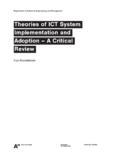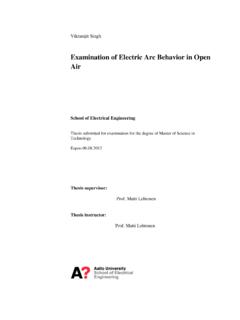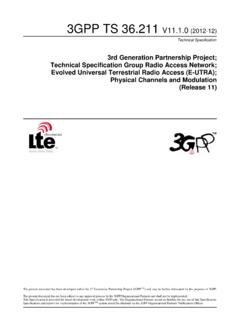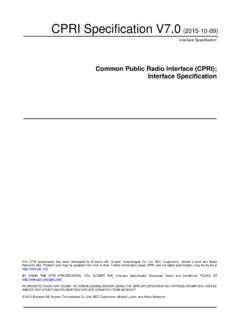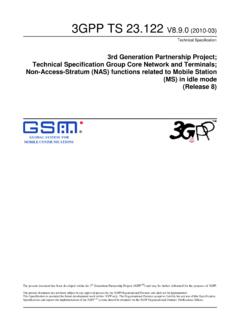Transcription of Dimensioning of LTE Network - University
1 Dimensioning of LTE Network Description of Models and Tool, Coverage and Capacity Estimation of 3 GPP Long Term Evolution radio interface Abdul Basit, Syed Masters Thesis submitted in partial fulfillment of the requirements for the Degree of Masters of Science in Technology Espoo, February, 2009 Supervisor: Professor Riku J ntti Instructor: Paolo Zanier ) DEDICATION To Prophet of Islam MUHAMMAD (Peace and blessings of God be upon him) ii HELSINKI University OF TECHNOLOGY Abstract of the Master s Thesis Author: Abdul Basit, Syed Name of Thesis: Dimensioning of LTE Network . Description of Models and Tools, Coverage and Capacity Estimation of 3 GPP Long Term Evolution Date: Number of Pages: 71 Department: Department of Electrical and Communications Engineering Professorship: S)72 Communications Laboratory Supervisor: Professor Riku J ntti Instructor: Paolo Zanier Long Term Evolution (LTE) is 3 GPP enhancement to the current cellular system in use.
2 The purpose of developing this system is to keep 3 GPP systems competent enough for decades to come. LTE is designed to have wider channels up to 20 MHz, with low latency and packet optimized radio access technology. The peak data rate envisaged for LTE is 100 Mbps in downlink and 50 Mbps in the uplink. With OFDM as the radio access technology, LTE has very promising features, like bandwidth scalability and both FDD and TDD duplexing methods. This thesis is related to the Dimensioning of LTE radio access networks and the development of tool for Dimensioning purpose. Different steps of the Dimensioning process are listed and explained. Methods and models for coverage and capacity planning are developed for Dimensioning of LTE radio access networks. Special emphasis is laid on radio link budget along with detailed coverage and capacity. The results are fabricated in an easy-to-use tool for Dimensioning .
3 The tool is made in Excel to serve the ease of working. Particular importance is given to clarity in the design of Dimensioning tool, achieved by dividing the tool into clearly defined sections. Inputs and outputs are placed on separate sheets. The Dimensioning tool calculates the number of cells needed to cover a given area with the user-provided parameters. Excel based tool covers all the basic aspects of the Dimensioning process for LTE Access Networks. Keywords: 3 GPP, LTE, Dimensioning , Network Planning, Capacity, Traffic Models. iii Table of Contents Table of iii List of List of List of 1 Introduction ..1 Objectives and 2 Dimensioning Thesis Layout .. 4 2 Long Term Evolution of 3 GPP (LTE) and LTE 6 Requirements for 6 Multiple Access 7 OFDMA for SC)FDMA for UL ..11 Bandwidth Scalability .. 12 Network Architecture .. 13 E)UTRAN 15 3 Dimensioning of LTE 17 Wireless Cellular Network 17 LTE Access Network 21 Inputs of LTE Outputs of LTE LTE Dimensioning 4 Coverage Planning and radio Link radio Link 28 iv Other)to)own cell interference (i).
4 32 Required 33 Spectral 36 Coverage)based Site Count .. 38 5 Capacity Planning ..40 LTE Capacity 40 Average Cell Throughput 41 Traffic demand estimation and Overbooking 43 Capacity based site 44 6 Tool for LTE Methodology and 45 Dimensioning inputs .. 46 Tables and background 48 radio link 50 Capacity 52 Dimensioning 53 7 Conclusion and Future Conclusion .. 56 Future Work .. 57 8 v Acknowledgments This Master s thesis was completed at Nokia Oyj during the period of June 2006 January 2007. I am deeply indebted to Dr. David Soldani and Paolo Zanier, who has been my instructors for this work. I am grateful for their cooperation, encouragement and invaluable guidance throughout the thesis. I must extend my gratitude to my supervisor, Professor Riku J ntti for being always so supportive and cooperative. I am deeply and forever obliged to my family for their love, support and encouragement throughout my entire life.
5 I am thankful to all my colleagues at Nokia for extending their technical support and advice during the work, especially Murad Keskinege, Flavio Parodi, Mikko Kylvaya, Paolo Zanier, Jose Alonso)Rubio and Michael Abromowski. At the end, my sincere thanks go to my friends and seniors at HUT for their help and motivation. Syed, Abdul Basit Espoo, February 2009 vi List of Abbreviations 2G 2nd Generations 3G 3rd Generations 3 GPP 3rd Generation Partnership Project ACK Acknowledgment aGW Access Gateway ARIB Association of radio Industries and Businesses ATIS Alliance for Telecommunications Industry Solutions ANSI American National Standards Institute BCCH Broadcast Control Channel. BW Bandwidth CAPEX Capital expenses CCPCH Common Control Physical Channel CCSA China Communications Standards Association CDF Cumulative Distribution Function CDMA Code Division Multiple Access CN Core Network CP Cyclic Prefix CQI Channel Quality Indicator DL Downlink DSCH Downlink Shared Channel DVB)H Digital Video Broadcast ) Handhelds E)UTRAN Enhanced UMTS Terrestrial radio Access Network eNB Enhanced Node B EPC Evolved Packet Core eSFN Enhanced System Frame Number ETSI European Telecommunications Standard Institute FDD Frequency Division Duplex FDMA Frequency Division Multiple Access GSM Global System for Mobile GPRS General Packet radio System viiGGSN Gateway GPRS Support Node HSDPA High Speed Downlink Packet Access HSPA High Speed Packet Access HSUPA High Speed Uplink Packet Access HS)DSCH High Speed Downlink Shared Channel HS)PDSCH High Speed Physical Downlink Shared Channel HS)
6 SCCH High Speed Shared Control Channel IP Internet Protocol IETF Internet Engineering Task Force L1 Layer 1 L2 Layer 2 LB Long Block LTE Long Term Evolution MAC Medium Access Control MBMS Multimedia Broadcast Multicast Service Mbps Megabits per second MCS Modulation Coding Scheme MME Mobility Management Entity MSC Mobile Switching Centre NFFT Number of Samples of FFT OBF Overbooking Factor OFDM Orthogonal Frequency Division Multiplexing OFDMA Orthogonal Frequency Division Multiple Access OPEX Operating Expenses PBCH Physical Broadcast Channel PCRF Policy and Charging Rules Function PDCCH Physical Downlink Control Channel PDCP Packet Data Convergence Protocol PDF Probability Distribution Function PDSCH Physical Downlink Shared Channel PHY Physical Layer PS Packet Switched PDSCH Physical Downlink Shared Channel viii PDSCCH Physical Downlink Shared Control Channel PUCCH Physical Uplink Control Channel PUSCH Physical Uplink Shared Channel QAM Quadrature Amplitude Modulation QoS Quality of Service QPSK Quadrature Phase Shift keying RAN radio Access Network RB Resource Block RLB radio Link Budget RLC radio Link Control RNC radio Network Controller RRC radio Resource Control SAE System Architecture Evolution SB Short Block SFN System Frame Number SGSN Serving GPRS Support Node SINR Signal to Interference and Noise Ratio SISO Single Input Single Output SNR Signal to Noise Ratio SC)FDMA Single Carrier)
7 Frequency Division Multiple Access SCTP Stream Control Transmission Protocol TDD Time Division Duplex TE Terminal Equipment TTA Telecommunications Technology Association TTC Telecommunication Technology Committee TTI Transmission Time Interval UE User Equipment UL Uplink UMTS Universal Mobile Telecommunication System UPE User Plane Entity UTRAN UMTS Terrestrial radio Access Network U)plane User Plane WCDMA Wideband Code Division Multiple Access WiMAX Worldwide Interoperability for Microwave Access ix List of Figures Figure 1-1: Flow chart of Project Work ---------------------------------------- ---------------------------------------- --- 3 Figure 2-1: OFDM Symbol Time Structure [11] ---------------------------------------- --------------------------------- 9 Table 2-1: Physical Layer parameters [11] ---------------------------------------- --------------------------------------- 9 Figure 2-2: Downlink frame structure for frames with short cyclic prefix [11] -------------------------------------10 Figure 2-3: Downlink frame structure for frames with long cyclic prefix [11] --------------------------------------11 Figure 2-4: UL Frame Structure for LTE [11]------------------------------------ ---------------------------------------1 1 Table 2-2: UL Physical Layer Parameters [11] ---------------------------------------- ---------------------------------12 Figure 2-5: E-UTRAN Architecture [4] ---------------------------------------- ---------------------------------------- ---13 Figure 2-6: E-UTRAN Interfaces [4]------------------------------------- ---------------------------------------- ---------15 Figure 3-1: General wireless cellular Network planning process ---------------------------------------- -------------18 Figure 3-2: General radio link budget of a wireless cellular Network [31] ---------------------------------------- --20 Figure 3-3.
8 LTE Network Dimensioning ---------------------------------------- ---------------------------------------- ---24 Figure 4-1: LTE spectral efficiency as function of G-factor (in dB) including curves for best Shannon fit [21] 35 Figure 4-2: CDF for G-factors of an LTE system (with different scenarios)[21] -----------------------------------36 Table 4-1: load versus Interference margin ---------------------------------------- --------------------------------------37 Figure 4-3: load versus Interference margin ---------------------------------------- ------------------------------------38 Figure 4-4: Three different types of sites (Omni-directional, bi-sector, tri-sector) ---------------------------------38 Table 5-1: DL average cell throughput for LTE ---------------------------------------- ---------------------------------42 Figure 6-1: Dimensioning tool: Capacity Inputs ---------------------------------------- --------------------------------47 Figure 6- 2: Dimensioning tool: Coverage Inputs ---------------------------------------- -------------------------------48 Figure 6- 3: Dimensioning tool: Traffic models ---------------------------------------- ---------------------------------49 Figure 6-4: Dimensioning tool: Capacity evaluator ---------------------------------------- ----------------------------51 Figure 6-5: Dimensioning tool: Capacity evaluator ---------------------------------------- ----------------------------52 Figure 6-6: Dimensioning tool: Forecast ---------------------------------------- ---------------------------------------- -53 Figure 6-7: Dimensioning tool: Outputs ---------------------------------------- ---------------------------------------- --55 List of Tables Table 2-1: Physical Layer parameters [11].
9 9 Table 2-2: UL Physical Layer Parameters [11] .. 12 Table 4-1: load versus Interference 37 Table 5-1: DL average cell throughput for LTE .. 42 1 1 Introduction Telecommunication industry is experiencing the emergence of a number of competing and enhancing technologies, including, WiMAX, HSPA, DVB)H. With the user requirements on the ever increasing side cellular networks are facing greater than ever competition from other technologies. HSPA (High speed packet access) and MBMS (multimedia broadcast and multicast service) has enhanced the 3G networks by bringing important capabilities, but these improvements are still not enough to match broadcasting technologies (such as DVB)H) or broadband wireless access (like WiMAX) for delivering modern services, mobile TV, internet access and other important services[1]. Therefore, 3G networks need a major overhaul to remain competitive in the future. In order to stay competitive in the long run, 3 GPP (Third generation partnership project) has initiated activity on the long term evolution of UTRAN (Universal Terrestrial radio Access Network ), which is eyeing clearly beyond to what the WCDMA can do with HSDPA or High Speed Uplink Packet Access (HSUPA).
10 3 GPP s answer to this demanding situation is 3G LTE (Long term evolution) or Super 3G, which could dramatically boost the capabilities of 3G networks and make it par with the other technologies [2]. 2 LTE is a system with larger bandwidths (up to 20 MHz), low latency and Packet optimized radio access technology having peak data rates of 100 Mbps in downlink and 50 Mbps in the uplink [3,4]. radio access technology for LTE is OFDM (Orthogonal frequency division multiplexing) which provides higher spectral efficiency and more robustness against mulitpath and fading, as compared to CDMA (Code division multiple access). In order to offer the operators increased flexibility in Network deployment, the LTE system supports bandwidth scalability and both FDD and TDD duplexing methods. The system also supports both unicast and multicast traffic in cell sizes from local area or micro cells (hundreds of meters) up to large macro cells (>10 km in radius) [4,5].


